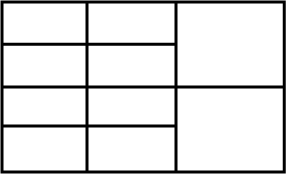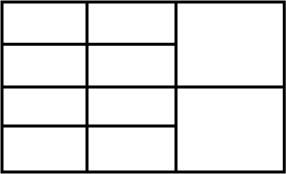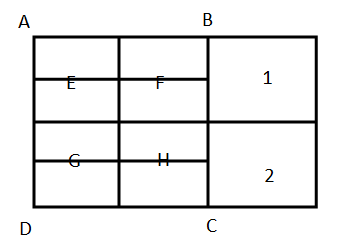
How many rectangles are there in the following figure?

A.\[39\]
B.\[25\]
C.\[30\]
D.\[38\]

Answer
549.6k+ views
Hint: The given question is about to find the number of rectangles in the given figure. In this question, we have to count every small or big rectangle that is made. We will count the total number of rectangles in the following figure by using a combination of identities to count the total number of rectangles.
Complete step-by-step answer:
In the given question, we have to find out the total number of rectangles in the following figure. Here, we will count every small rectangle that is made with a figure.
The given figure is:

This is the figure from which we have to calculate or count the total number of rectangles that is made here. For calculating the total number of rectangles, firstly we will name the vertices of the rectangle, so that the identification of the rectangle becomes easy.
On naming the vertices of the rectangle, we will make the figure.

This is the figure of the rectangle after naming the vertices. Here, we have made a partition in upper and lower rectangles too. In order to calculate the total number of rectangles, we will use the formula of combination where combination is nothing but it tells the total number of ways where order matters and the formula for arranging \[r\] out of \[n\] items, then the total number of way are given by:
\[{}^n{C_r} = \dfrac{{\left| \!{\underline {\,
n \,}} \right. }}{{\left| \!{\underline {\,
r \,}} \right. \left| \!{\underline {\,
{n - r} \,}} \right. }}\]
Here, total number of rectangles in the figure \[ABCD\] are:
There are \[3\] vertical lines and \[5\] horizontal lines, so total number of ways are \[{}^5{C_2} \times {}^3{C_2}\], where \[{}^5{C_2}\] is for horizontal lines taking \[2\] out of \[5\] and \[{}^3{C_2}\] is for vertical lines taking \[2\] out of \[3\] and on applying the formula of combination, we get:
\[\dfrac{{\left| \!{\underline {\,
5 \,}} \right. }}{{\left| \!{\underline {\,
2 \,}} \right. \left| \!{\underline {\,
3 \,}} \right. }} \times \dfrac{{\left| \!{\underline {\,
3 \,}} \right. }}{{\left| \!{\underline {\,
2 \,}} \right. \left| \!{\underline {\,
1 \,}} \right. }}\]
On using the formula of factorial, we get:
\[\dfrac{{5 \times 4 \times \left| \!{\underline {\,
3 \,}} \right. }}{{2 \times 1 \times \left| \!{\underline {\,
3 \,}} \right. }} \times \dfrac{{3 \times \left| \!{\underline {\,
2 \,}} \right. }}{{\left| \!{\underline {\,
2 \,}} \right. \times 1}}\]
\[5 \times 2 \times 3 = 30\]
So, total \[30\] rectangles.
But there are also more rectangles whose naming is:
\[1,2,12,1F,1FE,2HG,12FH,12EFGH,2H\]
So, total \[30 + 9 = 39\] rectangles are there.
So, option (A) is correct.
Note: The given question was about to find out the total number of rectangles. We had counted the total number of rectangles made by naming them, by making horizontal and vertical lines. In the same way, we can also find the total number of squares and total number of triangles formed in the other figure.
Complete step-by-step answer:
In the given question, we have to find out the total number of rectangles in the following figure. Here, we will count every small rectangle that is made with a figure.
The given figure is:

This is the figure from which we have to calculate or count the total number of rectangles that is made here. For calculating the total number of rectangles, firstly we will name the vertices of the rectangle, so that the identification of the rectangle becomes easy.
On naming the vertices of the rectangle, we will make the figure.

This is the figure of the rectangle after naming the vertices. Here, we have made a partition in upper and lower rectangles too. In order to calculate the total number of rectangles, we will use the formula of combination where combination is nothing but it tells the total number of ways where order matters and the formula for arranging \[r\] out of \[n\] items, then the total number of way are given by:
\[{}^n{C_r} = \dfrac{{\left| \!{\underline {\,
n \,}} \right. }}{{\left| \!{\underline {\,
r \,}} \right. \left| \!{\underline {\,
{n - r} \,}} \right. }}\]
Here, total number of rectangles in the figure \[ABCD\] are:
There are \[3\] vertical lines and \[5\] horizontal lines, so total number of ways are \[{}^5{C_2} \times {}^3{C_2}\], where \[{}^5{C_2}\] is for horizontal lines taking \[2\] out of \[5\] and \[{}^3{C_2}\] is for vertical lines taking \[2\] out of \[3\] and on applying the formula of combination, we get:
\[\dfrac{{\left| \!{\underline {\,
5 \,}} \right. }}{{\left| \!{\underline {\,
2 \,}} \right. \left| \!{\underline {\,
3 \,}} \right. }} \times \dfrac{{\left| \!{\underline {\,
3 \,}} \right. }}{{\left| \!{\underline {\,
2 \,}} \right. \left| \!{\underline {\,
1 \,}} \right. }}\]
On using the formula of factorial, we get:
\[\dfrac{{5 \times 4 \times \left| \!{\underline {\,
3 \,}} \right. }}{{2 \times 1 \times \left| \!{\underline {\,
3 \,}} \right. }} \times \dfrac{{3 \times \left| \!{\underline {\,
2 \,}} \right. }}{{\left| \!{\underline {\,
2 \,}} \right. \times 1}}\]
\[5 \times 2 \times 3 = 30\]
So, total \[30\] rectangles.
But there are also more rectangles whose naming is:
\[1,2,12,1F,1FE,2HG,12FH,12EFGH,2H\]
So, total \[30 + 9 = 39\] rectangles are there.
So, option (A) is correct.
Note: The given question was about to find out the total number of rectangles. We had counted the total number of rectangles made by naming them, by making horizontal and vertical lines. In the same way, we can also find the total number of squares and total number of triangles formed in the other figure.
Recently Updated Pages
Master Class 8 Maths: Engaging Questions & Answers for Success

Class 8 Question and Answer - Your Ultimate Solutions Guide

Master Class 7 Maths: Engaging Questions & Answers for Success

Class 7 Question and Answer - Your Ultimate Solutions Guide

Master Class 6 Maths: Engaging Questions & Answers for Success

Class 6 Question and Answer - Your Ultimate Solutions Guide

Trending doubts
What is meant by exothermic and endothermic reactions class 11 chemistry CBSE

Which animal has three hearts class 11 biology CBSE

10 examples of friction in our daily life

One Metric ton is equal to kg A 10000 B 1000 C 100 class 11 physics CBSE

1 Quintal is equal to a 110 kg b 10 kg c 100kg d 1000 class 11 physics CBSE

Difference Between Prokaryotic Cells and Eukaryotic Cells




